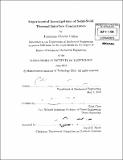Experimental investigations of solid-solid thermal interface conductance
Author(s)
Collins, Kimberlee C. (Kimberlee Chiyoko)
DownloadFull printable version (7.258Mb)
Other Contributors
Massachusetts Institute of Technology. Dept. of Mechanical Engineering.
Advisor
Gang Chen.
Terms of use
Metadata
Show full item recordAbstract
Understanding thermal interface conductance is important for nanoscale systems where interfaces can play a critical role in heat transport. In this thesis, pump and probe transient thermoreflectance methods are used to measure the thermal interface conductance between solid materials. Two experimental studies of thermal interface conductance are presented, each revealing the complexity of phonon interactions at interfaces which are inadequately captured by current models of phonon transmissivity. The first study considers interfaces of different metals with graphite, and finds that atomic-scale roughness at the interface could be appreciably influencing the heat transport due to the extreme anisotropy of graphite. The thermal interface conductance of graphite is found to be similar to that of diamond, suggesting that when estimating the thermal interface conductance between metal and multi-walled carbon nanotubes (MWCNTs), a reasonable assumption may be that the conductance with the side walls of the MWCNTs is similar to the conductance with the ends of the MWCNTs. The second study considered aluminum on diamond interfaces where the diamond samples were functionalized to have different chemical surface terminations. The surface termination of the diamond is found to significantly influence the heat flow, with oxygenated diamond, which is hydrophilic, exhibiting four times higher thermal interface conductance than hydrogen-treated diamond, which is hydrophobic. Microstructure analysis determined that the Al film formed similarly, independent of diamond surface termination, suggesting that differences in interface bonding likely caused the observed difference in thermal interface conductance, a phenomenon which is not captured in current models of solid-solid phonon transmissivity.
Description
Thesis (S.M.)--Massachusetts Institute of Technology, Dept. of Mechanical Engineering, 2010. Cataloged from PDF version of thesis. Includes bibliographical references (p. 70-84).
Date issued
2010Department
Massachusetts Institute of Technology. Department of Mechanical EngineeringPublisher
Massachusetts Institute of Technology
Keywords
Mechanical Engineering.